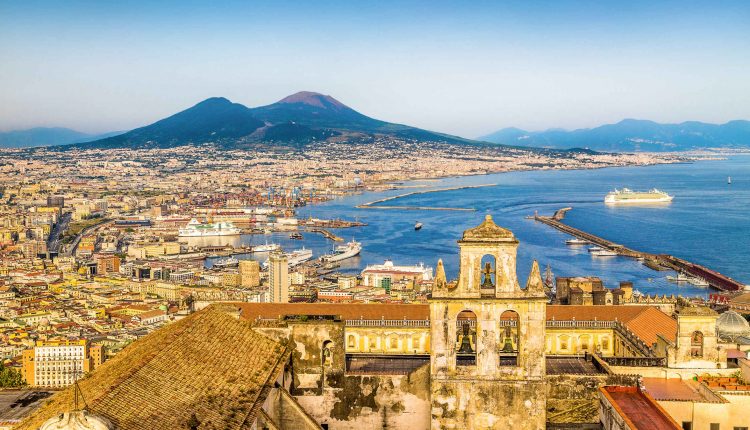Naples’ landmarks
Castel dell’Ovo
Megaride island was where the Greek colonists founded the original center of the city during the 6th century, BC. The castle’s location makes it a place with an outstanding view of Naples waterfront and its surrounding. During the 1st century BC, the Roman patrician Lucius Licinius Lucullus built the magnificent villa Castellum Lucullanum on the site.
The Normans built the first castle on the site during the 12th century. Castel dell’Ovo stayed important until King Charles I of Anjou build a new castle called “Castel Nuovo”, and then moved his court to that location. Castel dell’Ovo then turned into a prison.
A small fishing village called Borgo Marinaro got established around the castle’s eastern wall during the 19th century. This village is currently well known for its marina and restaurants.
The castle is approximately 200 by 45 meters and a large round tower stands outside the castle walls to the southeast. The area can be used for multiple usages such as taking wedding photos, holding special events and organizing exhibitions.
Underwater archaeologists have discovered what appears to be a 2500-year-old harbor associated with the origins of the first Greek settlement of Paleopolis (which preceded the ancient city of Neapolis, now Naples) in the sea next to the castle.
National Archaeological Museum
The National Archaeological Museum of Naples, which is said in Italian as Museo Archeologico Nazionale di Napoli, usually abbreviated as MANN, is an important Italian archaeological museum, especially for ancient Roman remains.
Its collection includes works from Greek and Roman times, and especially Roman artifacts from nearby such as Pompeii, Stabiae and Herculaneum. It was formerly the Real Museo Borbonico (“Royal Bourbon Museum”).
The museum includes wide range of collections of Greek and Roman antiquities. The main collection is from the Farnese collection, which includes a collection of engraved gems (including the Farnese Cup, a Ptolemaic bowl made of sardonyx agate and the most famous piece in the “Treasure of the Magnificent”, and is founded upon gems collected by Cosimo de’ Medici and Lorenzo il Magnifico in the 15th century) and the Farnese Marbles. From the distinguished works found in the museum are the Herculaneum papyri, carbonized by the eruption of Mount Vesuvius, found after 1752 in Villa of the Papyri.
The building was built as a cavalry barracks in 1585. From 1616 to 1777 it was the seat of the University of Naples. It became a museum in the 19th century; this is when it suffered from many changes to its main structure.
Marbles
The greater part of the museum’s classical sculpture collection largely comes from the Farnese Marbles, important since they include Roman copies of classical Greek sculpture, which are in many cases the only surviving indications of what the lost works by ancient Greek sculptors such as Calamis, Kritios and Nesiotes looked like. Many of these works, especially the larger ones, have been moved to the Museo di Capodimonte for display in recent years.
Galleria Umberto I
Galleria Umberto I is a public shopping gallery placed in Naples, southern Italy. It is located directly across from the San Carlo opera house. It was built during the year 1887 to the year 1891, and was the cornerstone in the rebuilding process of Naples — called the risanamento (meaning “making healthy again”) — that lasted until the World War I. It was designed by Emanuele Rocco, who employed modern architectural elements reminiscent of the Galleria Vittorio Emanuele II in Milan. The Galleria was named as Umberto I, the King of Italy at the time of construction. It was meant to combine businesses, shops, cafes and social life – public space- with private space in the apartments on the third floor.
The Galleria is a high and spacious cross-shaped structure, surmounted by a glass dome braced by 16 metal ribs. Of the four iron and glass-vaulted wings, one fronts on via Toledo (via Roma), still the main downtown thoroughfare, and another opens onto the San Carlo Theater. It has returned to being an active center of Neapolitan civic life after years of decay. The building is part of the UNESCO listing of the Historic Centre of Naples as a World Heritage Site.
The Galleria Umberto is the setting for The Gallery (1947) by the American writer John Horne Burns (1916–1953) based on his experiences as an American soldier in Naples shortly after the liberation of the city.
The international conference “Utopian and Sacred Architecture Studies” will be hosted at Naples, Italy. The conference will be a great chance to visit these places as part of the conference.
Click here to know more about the conference: https://bit.ly/2LrHqRj



